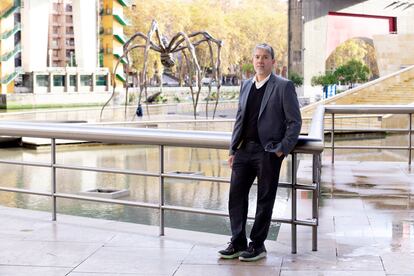As a young boy, Paul Pfeiffer (Honolulu, 58 years old) watched from backstage as his parents performed as musicians at a Protestant church in the Philippines. It shaped his practice as an artist. “Seeing the preparation, all of the work that goes into preparing — I grew up surrounded by the mechanics of production,” he recalls. Perhaps this why his exhibition that opened November 30 at the Guggenheim Museum Bilbao, Paul Pfeiffer: Prologue to the Story of the Birth of Freedom (runs though March 16, 2025) after its debut at The Museum of Contemporary Art, Los Angeles, takes on the form of a complex backstage, leading up to a final apotheosis. The show is a journey from the small-format videos of his early days as an artist to large-scale installations of overwhelming image and sound, all in the service of a reflection on identity and power dynamics. “My parents were less concerned with theology. They were more concerned with the sensory practices,” he explains amid the exhibition’s installation process, a week away from opening. “I’m looking for ways to both reproduce immersive experience while simultaneously calling attention to how plastic your emotions are and how they can be fabricated.”
Between his 10th and 15th birthdays, the Hawaiian lived with his family in the Philippines, part of a Protestant congregation in a largely Catholic country. “By contrast, the present Protestant culture has very few images. But in a sense, I grew up attracted to the visuality of the Catholic tradition. The other churches which were just down the street had super-extravagant imagery. In some ways, I didn’t fully understand the context for this until as an adult, I got a fellowship from the Fulbright Foundation in 1994 to spend a year in the Philippines.” He specifically cites the phenomenon of the Santo Niño de Cebú, a wooden Baby Jesus sculpture that Ferdinand Magellan brought to the island of Cebú in 1521 and which millions of devotees visit each January as part of a massive religious ritual. “It’s a real queer festival, actually. Obviously, it’s a kind of drag. It’s like code switching that adheres to a kind of traditional set of codes and, at the same time, transforms it from within. The image of Baby Jesus is super androgynous, and the owners of the image treat it almost as a doll.” He’s not surprised to hear a journalist note that something similar takes place in the popular Spanish religious events during, for example, Seville’s Holy Week, which has been pointed out in Jesús Pascual’s recent documentary ¡Dolores guapa! “I think many of the central devotees of this festival are specifically gender fluid,” says Pfeiffer.
The same play of opposites appears in the wooden sculptures of Justin Bieber’s body, tattoos included, that Pfeiffer made in 2017 after seeing a performance by the pop idol in Manila on Bieber’s Purpose tour. “Here’s this entertainment figure performing for a 55,000-seat arena, which is, in fact, a mega-church associated with a very specific religion, the Iglesia Ni Cristo, a Native formulation of Christianity that was started in the Philippines in 1915 and that became associated with the working-class.” In Pfeiffer’s work, Bieber is presented as a modern-day Baby Jesus, with all his contradictions.

It is impossible, when faced with Bieber’s fragmented body in the sculptures, not to flash on the crucifixion of Christ, another recurring image in Pfeiffer’s work that emerges in the basketball players of his video Fragment of a Crucifixion (After Francis Bacon), the photographic series The Four Horsemen of the Apocalypse and in the video installation Live From Neverland. In the latter, Pfeiffer works with source material from an actual 1993 video in which Michael Jackson proclaims his innocence on television in the face of accusations of sexual abuse. The artist inserts audio of Jackson’s words sung by a choir of adolescents. The viewer is torn between viewing Jackson as a criminal or as a sacrificial scapegoat. “[The choir] could be read as the young accusers of Michael Jackson, or they could be read in other ways. He’s literally using the mass media, which is attempting to criminalize him, to proclaim his innocence,” says the artist. “There’s this kind of mutual constitution happening between the choir and Michael Jackson. There’s something almost like Shakespearean or a Greek tragedy about this situation.”
For Pfeiffer, it was important to maintain a certain degree of ambiguity. That’s why he brings complex readings to a highly codified visual repertoire, typical of religion and major musical or sporting phenomena. “The imagery of Christianity as a kind of found object, like sports, I think, has a kind of familiarity, almost universally,” he says. “It’s impossible to not be exposed to it. I don’t come to it as a believer in religion or sports. It constitutes a kind of vessel which is preloaded with associations and meaning, like the performance of race and gender, and the codes of masculinity in the context of the popular arena.” These themes are not explicitly discussed in the works, but rather, the artist looks for the public to unravel his intentions. Pfeiffer believes that all art is political, even if the artist himself does not intend it as such.
He himself has a trajectory as an activist that dates back to the 1990s, when he first started living in New York — where he makes his home to this day — and joined the direct-action group ACT UP, which fights to raise awareness around the AIDS pandemic and those who live with and die from the virus. “At the time, it was difficult not to be involved with activism because it was such a big part of the East Village scene and culture,” he remembers. “The whole generation was caught up in a kind of culture war, like in the 1960s. In a way, today we are experiencing that same cycle, it’s impossible not to think of the early 1990s and 1960s. The obvious difference is the degree of mediatization, which amplifies the importance of image makers, of people in the cultural field like artists, musicians, writers. The style of politics now is less through verbal language and much more coming through the channels of sensory experience. Image-making, contemporary art, contemporary music, all these things seem right at the center of the culture war now.”
Pfeiffer already had a solo exhibition in Spain at Madrid’s carlier | gebauer gallery, which in 2021 showed a multimedia installation that included his sculpture of Justin Bieber’s torso. And it’s no coincidence that he has produced works in collaboration with Sevillan artisans, referencing a tradition that spread to the Spanish colony of the Philippines. “As I got deeper into the culture of religious image-making in the Philippines, I discovered that the primary commissioners of new images from these sculptors are politicians, and those that could afford to commissioned their images to be made in Spain. So in a sense, these are power images, and they represent a continuing lineage right into the present.” Of course, the process of decolonialization, so present in contemporary artistic discourse, is also on his agenda. Although, again, it is rarely expressly stated. “Obviously, things are changing and institutions are experiencing a kind of reckoning where they have to acknowledge that they need to correct the story. On an informal level, things are happening in the culture in the way we speak, how we dress, how we communicate with each other. As an artist, I’m more interested in playing with the plasticity of found images, because I think they do contain the DNA of history, and can contribute to a kind of poetry which in my opinion is rewiring our brains and our perception and sense of reality.”
Despite the formal refinement of Pfeiffer’s work, which combines these found images with artisanal procedures and sophisticated visual technologies, it also reflects the attention that the cultures of Native peoples and ancestral knowledge are generating in the discourses of contemporary art. “There are more and more artists who are exploring the pre-modern, with discourses close to anthropology or ethnography, and returning to the study of non-Western cultures that have been undervalued and related mostly to the past. I think there is now a very rich context in which to explore global culture from the present that can take us to very interesting places.”
Sign up for our weekly newsletter to get more English-language news coverage from EL PAÍS USA Edition




